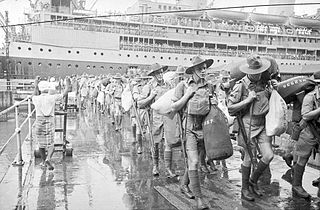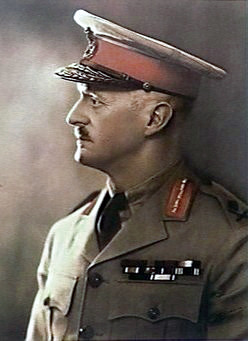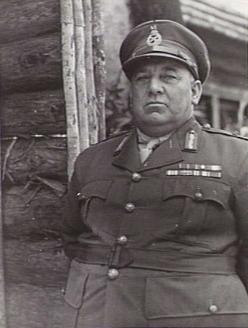Related Research Articles

The King's African Rifles (KAR) was a British Colonial Auxiliary Forces regiment raised from Britain's East African colonies in 1902. It primarily carried out internal security duties within these colonies along with military service elsewhere during the world wars and other conflicts, such as the Malayan Emergency and the Mau Mau uprising. The regiment's enlisted soldiers were drawn from the native Africans, while most officers were seconded from the British Army. During the 1960s, as part of the decolonisation of Africa, more African officers were commissioned into the regiment before it was gradually disbanded. KAR battalions would go on to form the core of newly established armed forces throughout East Africa.

The 8th Division was an infantry division of the Australian Army, formed during World War II as part of the all-volunteer Second Australian Imperial Force. The 8th Division was raised from volunteers for overseas service from July 1940 onwards. Consisting of three infantry brigades, the intention had been to deploy the division to the Middle East to join the other Australian divisions, but as war with Japan loomed in 1941, the division was divided into four separate forces, which were deployed in different parts of the Asia-Pacific region. All of these formations were destroyed as fighting forces by the end of February 1942 during the fighting for Singapore, and in Rabaul, Ambon, and Timor. Most members of the division became prisoners of war, waiting until the war ended in late 1945 to be liberated. One in three died in captivity.

Lieutenant General Henry Gordon Bennett, was a senior Australian Army officer who served in both World War I and World War II. Despite highly decorated achievements during World War I, during which he commanded at both battalion and brigade level and became the youngest general in the Australian Army, Bennett is best remembered for his role during the fall of Singapore in February 1942. As commander of the 8th Australian Division, he escaped while his men became prisoners of the Imperial Japanese Army. After this, Bennett's military career waned and, although he rose to command a corps, he never again commanded troops in battle. In 1945, his escape caused controversy and resulted in a Royal Commission and military enquiry. Both found that he had been unjustified in relinquishing his command.

Field Marshal Sir Thomas Albert Blamey, was an Australian general of the First and Second World Wars. He is the only Australian to attain the rank of field marshal.

Lieutenant General Sir Donald Beaumont Dunstan was an Australian Army officer who was Governor of South Australia from 23 April 1982 until 5 February 1991. A career officer, after joining the Army in 1940 during the Second World War, Dunstan graduated from the Royal Military College, Duntroon in 1942 and served as an infantry officer, seeing combat against the Japanese during the Bougainville Campaign in 1945. After the war, he served in a variety of appointments, including as commander of the 1st Australian Task Force during the Vietnam War. From 1977 to 1982 he held the appointment of Chief of the General Staff, before retiring from the Army having overseen a large-scale re-organisation. Afterwards, he became the longest-serving governor of South Australia. He died in 2011, at the age of 88.

The 16th Brigade was an infantry brigade in the Australian Army. First raised in 1912 as a Militia formation to provide training under the compulsory training scheme, the brigade was later re-raised as part of the First Australian Imperial Force during World War I. Its existence was short-lived, as it was disbanded after about six months, before it could be committed to the fighting on the Western Front. Raised again in 1939 for service during World War II, the brigade was deployed to the Middle East in early 1940 and subsequently saw action in the Western Desert and in Greece in 1941. In 1942, it returned to Australia in response to Japan's entry into the war, and later the brigade played a prominent role in the Kokoda Track campaign and at Buna–Gona in Papua. Withdrawn to Australia in early 1943, the 16th Brigade was re-organised and received many replacements from disbanding formations, but it was not recommitted to combat operations until late in the war. In 1944–1945, the brigade was committed to the Aitape–Wewak campaign in New Guinea. After the war, the brigade was disbanded in 1946. Today, its name is perpetuated by the 16th Aviation Brigade which was raised on 2 April 2002.

Lieutenant General Sir Horace Clement Hugh Robertson, was a senior officer in the Australian Army who served in the First World War, the Second World War and the Korean War. He was one of the first graduates of the Royal Military College, Duntroon, to reach the ranks of major general and lieutenant general.

The 1st Armoured Infantry Brigade was an infantry brigade of the British Army with a long history including service during both the First and the Second World Wars. It was based at Tidworth Camp. Previously, it has been designated 1st (Guards) Brigade, 1st Infantry Brigade, 1st Mechanised Brigade, and under the initial Army 2020 reforms assumed the title of 1st Armoured Infantry Brigade. Under the Future Soldier programme, the brigade merged with the 1st Artillery Brigade to form the 1st Deep Recce Strike Brigade Combat Team.

General Sir Gerald William Lathbury, was a senior British Army officer who fought during the Second World War, serving with distinction with the British Army's airborne forces, commanding the 1st Parachute Brigade in Sicily, Italy and Holland. He later became Governor of Gibraltar from 1965 to 1969.

Major General Sir George Frederick Wootten, was a senior Australian Army officer, public servant, right wing political activist and solicitor. He rose to the rank of temporary major general during the Second World War. Wootten earned the respect of his soldiers and superiors; General Douglas MacArthur described him as "the best soldier in the Australian Army who had it in him to reach the highest position". He was famous, in part, for his heavy build; he had given up smoking in 1930, and by 1941—even though he was 175 cm tall—he weighed 127 kg.
Major General Sir Rohan Delacombe, was a senior British Army officer. After he retired from the army, he was the last British-born Governor of Victoria, Australia from 1963 to 1974.
Lieutenant General Sir Vernon Ashton Hobart Sturdee, was an Australian Army commander who served two terms as Chief of the General Staff. A regular officer of the Royal Australian Engineers who joined the Militia in 1908, he was one of the original Anzacs during the First World War, participating in the landing at Gallipoli on 25 April 1915. In the campaign that followed, he commanded the 5th Field Company, before going on to lead the 8th Field Company and the 4th Pioneer Battalion on the Western Front. In 1918 he was seconded to General Headquarters (GHQ) British Expeditionary Force as a staff officer.

Major General Paul Alfred Cullen, was a senior officer in the Australian Army. He joined the Militia in 1927 and saw active service throughout the Second World War, distinguishing himself as a fighting battalion commander on the Kokoda Track. Post war, he continued to serve in the Citizen Military Forces (CMF) and rose to the rank of major general as the CMF Member of the Military Board.

The 21st Brigade was a brigade-sized infantry unit of the Australian Army. It was briefly raised in 1912 as a Militia formation providing training as part of the compulsory training scheme. Later, it was re-formed in April 1940 as part of the Second Australian Imperial Force, the unit was raised for service during World War II. As part of the 7th Division the brigade's constituent units were raised from volunteers from several Australian states. After rudimentary training in Australia, the brigade deployed for the Middle East in October 1940. Defensive duties were mounted along the Libyan border in early 1941, before the brigade was committed to the Syria-Lebanon campaign, fighting against Vichy French forces. In early 1942, following Japan's entry into the war, the brigade returned to Australia. After a period of defensive duties in Australia, it was deployed to New Guinea and subsequently played a key role in the Kokoda Track campaign, delaying the Japanese advance towards Port Moresby and then joining the pursuit as the Japanese withdrew towards Buna–Gona. In 1943–1944, the brigade took part in the capture of Lae and the Ramu Valley–Finisterre Range campaign. Its final campaign of the war, came in the final months when it took part in the Balikpapan landings. It was disbanded in 1946.

The 22nd Brigade was a brigade-sized infantry unit of the Australian Army. It was briefly raised in 1912 as a Militia formation providing training as part of the compulsory training scheme. Later, during World War II, the brigade was raised as part of the all volunteer Second Australian Imperial Force in April 1940. Assigned to the 8th Division, in early 1941 the brigade was deployed to British Malaya, where it formed part of the defensive garrison that was established there by the British, eventually establishing its headquarters in the Mersing–Endau area.

Lieutenant General Sir Alwyn Ragnar Garrett, KBE, CB was a senior commander in the Australian Army. He served as Chief of the General Staff (CGS) from 1958 to 1960.
Brigadier Thomas Haddon was a British Army officer who served with the airborne forces during the Second World War, most notably during Operation Market Garden in September 1944. Following the war he raised the Singapore Military Forces and served as Chief of Staff of Hong Kong Land Forces.

Major General Eric Clive Pegus Plant, was an officer in the Australian Army who served during the First and Second World Wars. Plant served in the pre-war part-time military from 1908, before joining the permanent forces in 1912. During the First World War, he volunteered for the First Australian Imperial Force and served at Gallipoli in 1915 as the adjutant of an infantry battalion. Later, he served as a staff officer at both brigade and divisional levels on the Western Front between 1916 and 1918, reaching the rank of lieutenant colonel.
The 2/21st Battalion was an infantry battalion of the Australian Army. Raised for service during Second World War as part of the Second Australian Imperial Force, it was formed on 11 July 1940 at Trawool in central Victoria as part of the 23rd Brigade of the 8th Division. It was subsequently deployed to Ambon as part of Gull Force in December 1941 following the Japanese invasion of Malaya; however, with the defence of the island considered untenable due to the limited military resources available and overwhelming Japanese strength it was subsequently captured despite determined resistance, surrendering on 3 February 1942. Most members of the battalion became prisoners of war, and a large number died in captivity.

Major General Victor Paul Hildebrandt Stantke, was a senior officer in the Australian Army, serving during the First World War and Second World War. His appointments were mainly to staff and administrative postings, including holding the position of Adjutant-General from 1940 to 1943, and commander Queensland Lines of Communication Area from 1943 to 1946.
References
- ↑ "Temporary Brigadier Tom Warren White". Australian War Memorial. Retrieved 21 December 2020.
- 1 2 3 4 "Australians in Berlin". The West Australian. Retrieved 22 December 2020.
- 1 2 "2/1st Australian Infantry Battalion". Australian War Memorial. Retrieved 22 December 2020.
- ↑ "Australian in Berlin gets US honour". The Argus. Retrieved 22 December 2020.